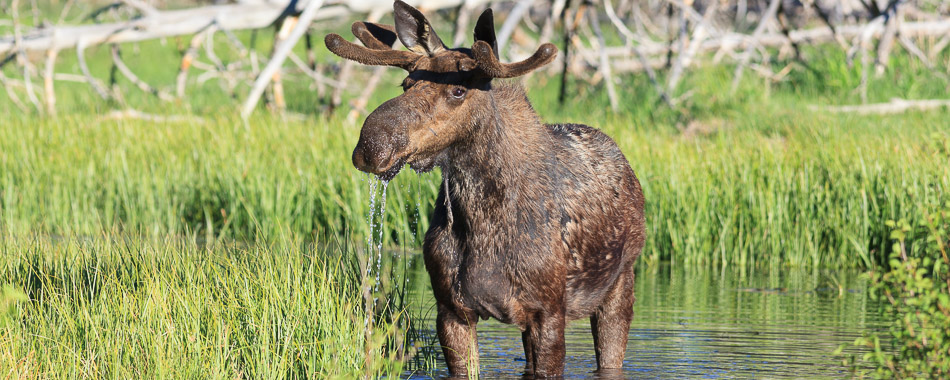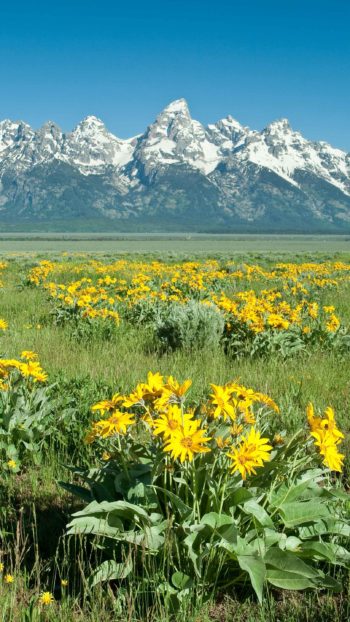Grand Teton National Park is currently working through the decision process of what should be done, if anything, to improve the Moose-Wilson Road. This narrow, winding, wildlife filled route connects Moose, Wyoming (Grand Teton National Park headquarters and the Craig Thomas Visitor Center) with Teton Village and state highway 390. The roadway is not only a relied upon route on the west bank of the Snake River, it also provides visitor access to popular trailheads, world famous wildlife viewing and is used by cyclists. Along with increasing park visitation, there is also an increase in visitor awareness of this great park road combined with visitors accessing the relatively new Laurance Rockefeller Preserve (LSR). Combine this with fast moving commuter traffic and pressure on the park to provide more opportunities for bicyclists and the stage is set for potential conflict.
As a wildlife tour company we spend a lot of time on the Moose-Wilson Road and take are guests there at least once on almost every trip we operate. Even when we are not guiding clients, we are often out there ourselves in search of wildlife and enjoying the unusual richness of this little corner of Jackson Hole (I was just there this morning!). Over the years there has definitely been an increase in traffic through the corridor but despite that the experience and wildlife opportunities have remained largely unchanged. There are some that are participating in the public process claiming a significantly denuded experience and dangerous conditions that must be fixed immediately. There are special interest groups advocating for closing the road to all but their user group or limiting access to the area using a reservation system. Even worse some are advocating for rerouting large parts of the road closer to the Snake River (and consequently deeper into the bottomland habitat they claim to want to save) or adding new pathways that would widen or add another transportation corridor.
Out of the plans being put forth so far, the only one I can support is the no change option. All of the others are throwing the baby out with the bath water by either limiting access unnecessarily or increasing the impact of the travel corridor by cutting new roadbeds and pathways through this pristine and wildlife rich corner of Grand Teton National Park. As the park weighs all of these proposals your feedback is critical to maintain this fantastic experience. The following are some points I would encourage you to keep in mind as you formulate your own opinion on the subject:
1. There really isn’t a major problem! We are out there every day and choose to return day after day. The experiences we are able to have out there are amazing and continue to be worth the trip! The rural character of the road with the twists and turns and overhanging vegetation is part of the experience. A major redesign or reroute would not only change the experience but also speed up traffic and impact untouched pristine habitat. This is so drastically different from most modern roadways that we forget what we have lost in those other places that have been widened and modernized in the name of safety and efficiency.
2. Non-motorized users stress and disturb wildlife more than motorized users. Though counter-intuitive this is widely documented by research done on winter use in Yellowstone and can easily be observed. Try riding a bike or walking through a herd of bison or past a moose. They will either run away or run you over. We do the same thing in a car daily without incident. A car acts like a blind that most animals don’t react negatively towards (loud diesel engines and motorcycles will sometimes spook the more timid species but even in these cases they usually just look up). If you were to either add a new pathway for non-motorized use or close the road for those activities the impact and disturbance to wildlife would certainly be greater and conflicts would increase. Try riding a bike or jogging through bushes filled with ripe berries and see how many surprise encounters with bears and moose happen!
2. Suggestions to close the road or limit access to motor vehicles would limit access to a large portion of the traveling public that currently use the road. The experiences they are able to have with wildlife and the natural world, even in their vehicles, are unprecedented in most places. When visitors are able to Some of the comments are saying that people should get out of their cars and walk but this viewpoint doesn’t address the primary reasons for using the road. As a matter of fact, a lot of the new traffic are people driving to the LSR to take a walk! Again go back to point number 1 and remember that the more people are out on the landscape the more impact the park will see. Wildlife do not like people on foot and in most cases hide or flee. As an experienced wildlife photographer and tracker I can say definitively from thousands of hours in the field that I have way more encounters with wildlife in a car than while hiking.
3. Small changes to the road could alleviate most of the concerns without massive and radical changes to the route, habitat and most importantly access. First I would reduce the speed limit to 15-20 mph. The current speed limits are way too high for the road and given that most people are driving 5mph over the current limit should be drastically reduced. Speed bumps and warning signs should be installed in places with common wildlife sightings and blind corners and speed enforcement should be stepped up to slow down the faster moving commuters. Pullouts along the route should be slightly expanded to allow slower moving traffic or people watching wildlife to pullover off the roadway. Lastly I would add signage at each end of the road reminding people to slow down, be patient, be courteous to others and to remember this is not a highway or shortcut. The purpose of the national park is to protect the resource and provide access for the public. Their mission is in no way to provide fast, efficient travel through the park. By slowing down traffic we will make the road safer for non-motorized users without increasing the footprint of the road for a separate pathway.
4. Make small fixes to the very north and south ends of the road to make them safer for bicyclists and people on foot. The hill on the north side with the blind rollover could be improved and the road straightened to bring the outlet inside the park gates. This will detour those using the road as a shortcut by making them enter the park and pay the park entrance as they have to do on the south side. Our experience and most common complaint is that cab drivers using the road as a shortcut are the fastest moving cars on the road. When they drive fast and tailgate, they inevitably speed visitors up that are in front and behind them. The south side could use a little work to widen a couple tight pinchpoints and widen a couple sharp turns to make them safer.
You can learn more about the proposals and participate in the process by visiting the Grand Teton Park website dedicated to the Moose-Wilson Road. http://www.nps.gov/grte/parkmgmt/mwccmp.htm Let’s try to keep the road we love relatively unchanged for future visitors!

